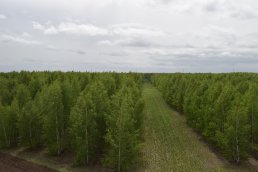First appeared in

Asian Development Bank
100 Climate Actions from Cities in Asia and the Pacific
A 30-year long afforestation project around Kazakhstan’s capital aims to create a protective green belt around the city by planting trees in the previously barren steppe.
A 30-year long afforestation project around Kazakhstan’s capital aims to create a protective green belt around the city by planting trees in the previously barren steppe.
Nur-Sultan has made a significant effort to overcome environmental challenges related to local climatic conditions, emissions, and air pollution through the creation of a forested ring around the city. More than 83,000 hectares (ha) of forest have been introduced since the late 1990s, with more than 5,000 coniferous and deciduous trees added every year.
Scientists that first embarked on the large-scale afforestation project in 1998. Learning from early results, the city has seen improvements in tree survival rates; the forests are now home to a variety of animals and plants, and are being used by citizens in the summer for recreational activities.
83K
HECTARES OF FOREST INTRODUCED
HECTARES OF FOREST INTRODUCED
Afforestation has been hailed as a strategy with significant global carbon sequestration potential, and although not the original goal of the project, will be an important result. The trees within and around the city will also create a number of other benefits for residents of Nur-Sultan, including protection from extreme weather events as well as a reduction in wind speeds hitting the city.

Nur-Sultan’s green belt is a ring of newly planted forests around the capital city as well as a network of green spaces throughout the city for citizens to enjoy (photo by Astana Ormany LLP).
The Challenge
Kazakhstan’s capital Nur-Sultan lies in the northern steppe region and is characterized by high winds, freezing winter temperatures, and baking hot summers. These climatic factors combined with saline soils made for serious initial challenges.
Co-Benefits
Social The Green Belt is a place for citizens to enjoy leisure activities such as running, cycling, and walking. Bicycles are available to rent to explore the area. The project has also created local jobs in planning, planting, and operations.
Environment Large scale reforestation is also expected to have positive effects for biodiversity conservation, as forests provide habitat for a broad range of species.

